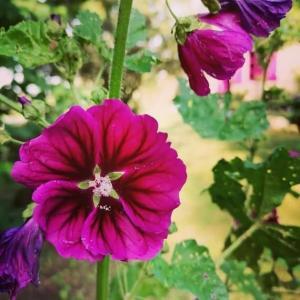Took some time out this morning to admire our beloved Mauve des Bois (Malva Sylvestris), that has just started it’s floral splendor. Also known as cheese mallow, high mallow or tall mallow, she’s a real enchanter with her showy flowers of bright mauve/purple and dark veins. She grows freely in meadows, hedgerows and in fallow fields, but obviously at Les Pierres too, where we love her so much that we couldn’t wait for her to propagate herself naturally so we nursed 5 more plants from seeds this spring. They are now growing in the same spot and will hopefully increase harvest next year.
The plant contains essential oil, tannins, flavonoids and anthocyanins, especially in the flowers and has an extended history as a medicinal herb. She has also been a popular vegetable for a long time. We like to dry the flowers for use in our tea blends, which is supposed to help against a sore throat, due to the presence of mucilage in the flowers.
For the same purpose we planted seeds of another species of Mallow this year, the marsh-mallow (Althaea officinalis), which possesses it’s properties in a superior degree but is equally beautiful with striking white flowers. They are still tiny though and we have not planted them out yet.
Equally beautiful with striking white flowers
Trying to make ones life sustainable is more than a personal choice and almost automatically leads to a multitude of decisions you have never even thought of before. On this website we share what works for us, or woefully no longer works, obviously without claiming the same for you.
We hope that our journey towards a supplementary comprehensive celebration of nature’s beauty might just clear a pathway forward for you too, perhaps challenges a revealing reconsideration, or simply provides for an equally indispensable diversion.
Can we change the world through food? We believe we can and we support Slow Food, a global movement of local communities and activists across more than 160 countries. Together we defend cultural and biological diversity, promote food education and the transfer of traditional knowledge and skills.


